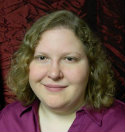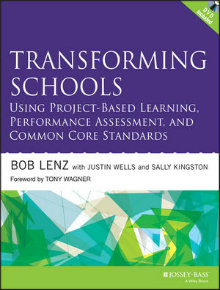How to Create a PBL, Performance-Driven School
Transforming Schools: Using Project-Based Learning, Performance Assessment, and Common Core Standards
By Bob Lenz with Justin Wells and Sally Kingston
(Jossey-Bass, 2015 – Learn more)

The first thing you need to know about Transforming Schools: Using Project-Based Learning, Performance Assessment, and Common Core Standards is that it is co-authored by several founders of Envision Education, a non-profit that manages three charter schools in the San Francisco region and also offers training in its methods through a for-profit arm.
This is not to say that the book is without merit, but it does color all of the content, so it’s helpful to know that up front.

I particularly love that students have to do a portfolio defense, (think scholastic thesis or dissertation defense), rather than being presented with a diploma as a matter of course, solely based on a final letter grade or numerical decimal points.
So What’s It All About, Then?
The purpose of this book is to demonstrate how a school can thrive based on an educational platform of project-based learning and performance assessment.
In a nutshell, beginning as freshmen, students at the three Envision Schools are required to complete (and thus teachers are required to design and assign) a number of multidisciplinary, standards-based projects each year. These projects are assigned in various content areas, usually one or two a year per teacher, and may fit into one of the following four performances: a research paper, an analysis, an inquiry, or a creative expression.
Ideally, each student will complete at least one of each kind of performance per year. Then, as they approach their senior year, they have to choose the best of these performances for inclusion in a graduation portfolio, which they must defend in timely fashion before a panel of teachers to earn their diploma.
Success is not guaranteed; many students “fail” the first time, and are required to revise and re-present their new and improved defense. According to the authors, “failure does not mean ‘You lose’; it means ‘You can do better. Here is some feedback; revise, and try again.’”
Revision, in fact, is an essential element of the performance assessment structure, both during the completion of the projects and as a part of the final portfolio defense.
Performance assessment principles
There are seven beliefs that guide the Envision system of performance assessment, tenets held by all the teachers of the Envision Schools:
- Ability is not fixed; through effort, it grows.
- Failure is essential to learning.
- Revision is the route to mastery.
- Knowledge deepens and expands through inquiry.
- Teaching is coaching.
- Caring is essential to accomplishment.
- Learning can (and should) be fun.
These beliefs are layered within and throughout the structure of the Envision approach to teaching and learning, which is part of what makes it such a successful endeavor. In the authors’ opinion, this scholastic design needs to be built from the ground up and will fail if it is haphazardly implemented without first assessing the challenges to the school presented by the processes and the possible solutions to overcome them.
The Book, Beginning to End
The book begins with a rationale for why this system was implemented in the first place: a cursory examination of the state of American education, the fundamental lack of real-world readiness students seem to have, and their inability to thrive in the rigorous academic environment of higher education, even though they appear to have been successful in a secondary setting.
Then, in Chapter 2, “Designing a Standards-Aligned Performance Assessment System,” the authors dive into the specifics of how the system works, breaking down the project elements and portfolio requirements, accompanied by project examples and anecdotes. This is where the heart of the book lies. Everything preceding and following Chapter 2 is just supporting evidence – what schools need to succeed, why certain elements are important, and how to get started.
Many teachers and school leaders already know much of this information, at least in theory if not in practice. It is how the Envision schools have sifted through that information and pieced it together to form one solid and coherent structure for performance-based inquiry assessment that is the diamond in the rough. Chapter 2 gives readers a concrete example of what the structure looks like and how it works. Without it, the book would not be worth reading.
The authors anticipate the pushback
Even after reading all about the layout and components of this learning and assessment system, as impressive as it is, it would be easy to say, “well, this would never work in my school; this is an ideal system for an ideal setting – we live in the real world.”
That is exactly the reaction Lenz, Wells, and Kingston want to avoid. So in the next five chapters, they include a more in-depth explanation of project-based learning, explain how to begin transforming school culture and school systems, give school leaders advice on how to navigate these transformations, and provide three strategies for getting started in their final call to action.
Given that this system was propagated and grew up in a charter school setting, it would be foolish to assume that this can be easily replicated overnight. However, I strongly encourage teachers who are interested in changing their current system to use this as a discussion tool with school and district administrators.
The challenges we will face
The first challenge is most likely going to be reaching a building or district-wide consensus that tenets like the ones listed above not only have educational merit but should be given priority. Unless educators really believe in an educational philosophy where elements like fail-and-try-again are fundamental to quality education (rather than relentlessly focusing on success and forging onward with pedagogical blinders on), then the dream of transforming schools into something resembling the models in this book is doomed to failure.
However, for those stalwart educators who are intrigued by the possibilities presented, Lenz and Co. include all of the rubrics and planning documents in the second half of the book to provide project planners with concrete examples for inspiration. A DVD containing video anecdotes from teachers and students referenced in the book is also included. And there’s a companion website.
Readers should not be daunted. If you can set aside the charter-school vibe in Transforming Schools and focus on using the information provided to design a system that can work in your school, this book can get you there.
Michaela Schied is a middle school teacher librarian at the Indian River Middle School in Philadelphia, NY. An avid reader and occasional singer, she chairs the school’s teacher and student library advisory groups and runs the annual spelling bee. She also provides professional development to teachers, focusing on inquiry and project-based learning. In her non-working hours, Mickey serves on the board of the New York Library Association’s Section of School Librarians and is on the planning committee for the Thousand Islands Book Festival in Cape Vincent, NY.































Where can I find more PBL resources geared towards elementary…. Especially math.